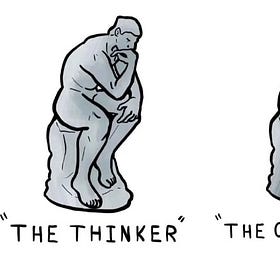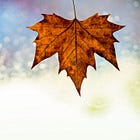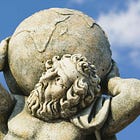How can I stand on the ground every day and not feel its power?
How can I live my life stepping on this stuff and not wonder at it?
—William Bryant Logan, Dirt: The Ecstatic Skin of the Earth*
*With big thanks to Dohnut for recommending this book!
Catch up on part one here first:
Where we left off . . .
Terroir, a French word for soil or land, has a richer meaning than its direct translation. When referencing food production—such as for wine, whiskey, cheese, chocolate, coffee, olive oil, tea, cider, maple syrup, milk, and honey—it means sense of place, or “the taste imparted into food by its environment; by the synthesis of sun, soil, temperature, and a touch of human tending.”
Goût de terroir translates to “taste of the land.”1 Sommeliers pass their exams by identifying the distinct time-and-place a wine evokes. Through years of training and a refined palate, they match a wine’s mouthfeel to its region and vintage. Each sip reflects back a blend of influences, including climate, soil, topography, wind, geography, biodiversity, human influence, and more.2
Others say the idea of terroir is mostly a marketing trick, meant to elevate French wines from riff-raff competitors around other parts of the world.3 It is true that French winemakers played up the idea of terroir after an embarrassing rout in the 1976 “Judgment of Paris,” a blind-tasting event where Californian wines unexpectedly outperformed esteemed French wines.4
It doesn’t escape me that terroir is only one letter away from terror, the existential “i” of staring into the abyss.5
If my 2024 had a terroir, it would be a combination of:
Quiet mornings reading in the dark, black coffee in my favorite teal diner mug
Crisp morning outings and warm afternoons with Ryder while listening to writing podcasts, either kicking his ball or sitting together in the dirt of our favorite fields in New York City.
A flurry of Spring business activity culminating in terrible neck pain
A pivotal mid-year ER visit due to a half-frozen face, drool dribbling while attempting to sip water, followed by joining a gym two days later
The blissful inhales of cold, wet eucalyptus towels that regularly greet me there, signaling arrival and self-care
Transforming a lifelong aversion of saunas and steam rooms into newfound peace, embracing the luxury of sinking into those cedar benches after a workout.
Email inboxes receding far into the background6 while clawing my way toward reclaiming health and wellness—mentally, physically, and spiritually.
An abundance of cozy evenings at home, watching movies with Michael, while Ryder scatters the toys from his bin, enticing us to play.
I’m grateful to Dohnut and business bestie (of fifteen years!) , a brilliant writer and editor, who helped explore the etymology further in part one’s comments:
“I’m pulled to the comparison of terroir and noir, obviously pulling their French suffix structure into conflated etymologies in my "Inbox Subject Line Skim" brain.
Noir, originally meaning black in French; and culturally meaning a genre of anything bleak, dark, and a bit cynical—[think] seedy crimes and black-and-white classics.
So learning about the seedy dark dirt roots of terroir, it makes sense in my word mind to see similarities in the two studies. How there would be a sense of ‘-oir’ to the hard fought, scraping up from the depths of the soil, transformation that we sometimes go through.”
I have always resonated with the image of a taproot. As a plant grows taller, emboldened by the sun, its roots dig deeper, further into the darkness. Or, put another way per Thích Nhất Hạnh, “No mud, no lotus.”
According to Wine Folly, most sommelier certifications include three parts:
Tasting: Proving sensory acuteness and ability to make connections between where a wine is from and its basic characteristics, correlating an unknown wine (via blind taste test) to a region, variety (or blend), and vintage.
Theory: Depth of understanding of classic wines, regions, history, and geography.
Service: Physical abilities to communicate, sell, and serve still or sparkling wine.
Perhaps we can all attempt to identify the terroir of our creative soil . . . as blind as the taste test still may feel. When reflecting on this last year (or five):
Taste: How have you grown? What is the quality of the soil beneath your feet? What has your emotional “weather” been like? How has your taste shifted?
Theory: What have you learned as a result? How have you transformed? Who are you now that you weren’t before? What did you lose? What did you gain? What theories do you hold about the world and your place in it, and which ones no longer hold purchase in your mind?
Service: How will you share your boons, large and small, when it’s time?
Or maybe, like me, you are still watering and reflecting, watching and hoping, harvesting and fermenting, mulling and aging.7
❤️
P.S. I’ll leave you with a poem I encountered this morning, “Clearing” by Martha Postlethwaite, with thanks to for surfacing it:
Do not try to save
the whole world
or do anything grandiose.
Instead, create
a clearing
in the dense forest
of your life
and wait there
patiently,
until the song
that is your life
falls into your own cupped hands
and you recognize and greet it.
Only then will you know
how to give yourself to this world
so worthy of rescue.
—Martha Postlethwaite, “Clearing”
🌊 There’s also merroir (not to be confused with memoir :). It means “from the sea,” based on the French mer (sea). Merrior features include:
Salinity: The saltiness of the water has a profound effect on the flavor of seafood, especially oysters and clams.
Mineral Content: Water rich in certain minerals can lend unique flavors to shellfish or fish.
Tides and Currents: The movement of water affects how seafood grows, influencing its texture and flavor.
Ecosystems: Local flora and fauna in the water, such as plankton and algae, contribute to the taste and nutrient profile.
🎥 Three must-watch movies for wine aficionados—aka oenophiles, who knew?!—include Somm, Sideways, and Sour Grapes.
🍷🧀 MasterClass also has a Wine Appreciation class, a Sommolier’s Snob-Free Guide to Wine, and legendary chef Thomas Keller on Cooking Techniques.
With thanks to Wikipedia, here are even more movies featuring terroir as a co-star:
Documentaries: Mondovino (2004) exploring the globalization of the wine business; the S1 E4 episode of BBC’s 2006 series, Oz and James's Big Wine Adventure; and All In This Tea, a 2007 documentary exploring the importance of terroir and organic growing methods for the quality and future sustainability of the Chinese tea market.
Film references include the 1995 movie French Kiss starring Meg Ryan; A Good Year, Ridley Scott’s 2006 British rom-com starring Russell Crowe; a plot turning point in the 1976 French comedy L'aile ou la cuisse (The Wing or the Thigh); and in the 2014 Edgar Allan Poe-inspired film Terroir, in which a “wealthy wine maker hires Tuscan wine detective to discover the source of a mysterious bottle of wine,” based on Edgar Allan Poe’s “The Cask of Amontillado.”
🎧 The first definition of terroir is via Emergence Magazine Podcast’s episode, “Holy Terroir: Finding Taste in an Edge-Place” by Lily Kelting:
🎧 Via the VinePair podcast episode, “Is ‘Terroir’ Just French for Bullshit?”
📈 From Wine Economics, “This strategy was instrumental in maintaining their wines’ prestige and market share in the face of growing global competition.”
This outcome challenged the perceived supremacy of French wines and prompted French winemakers to further emphasize terroir as a means to protect their market position and to underscore the unique qualities that set their wines apart from international competitors.
By focusing on terroir, French winemakers aimed to preserve the cultural and geographic distinctiveness of their wines, reinforcing the notion that their unique environmental conditions and traditional practices could not be replicated elsewhere.
Similarly, the only difference between falling and failing, typographically speaking, is a mere third of a letter, that same beguiling “i” for identity, or maybe “l” for loss and hopefully learning—but that’s for another Doh on another day.
If you wrote and I never replied, please know: it’s me, not you.
🐌 Are you mad at me? Part One
“Introversion—along with its cousins sensitivity, seriousness, and shyness—is now a second-class personality trait, somewhere between a disappointment and a pathology.
🍩 If you enjoyed this post, you might also appreciate:












Another great/recent wine series - Drops of God on Apple+. A must-see when contemplating terroir on so many levels: "While the world of wine mourns the death of Alexandre Leger, his estranged daughter, Camille, learns his extraordinary collection is now hers. But before she can claim her inheritence, Camille must best her father's protege in a test of their senses."
As always your writing is my favorite companion to my morning coffee and a special thank you for sharing "The Clearing" - that resonated with me deeply this morning.